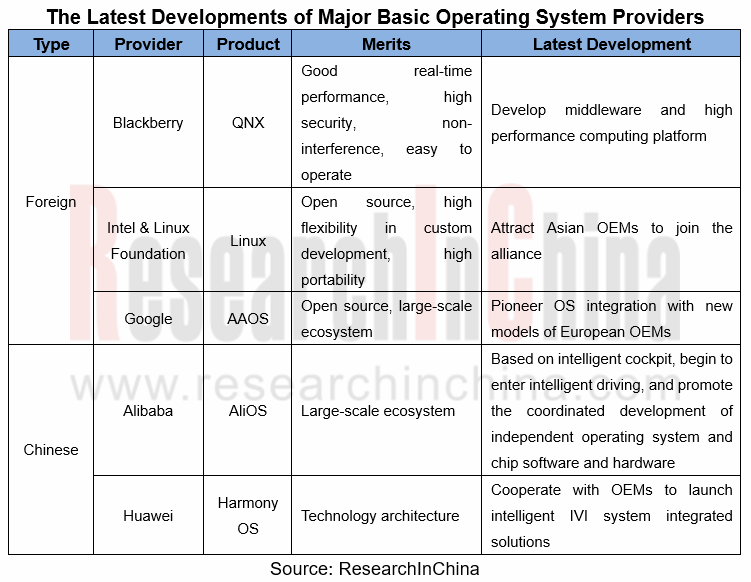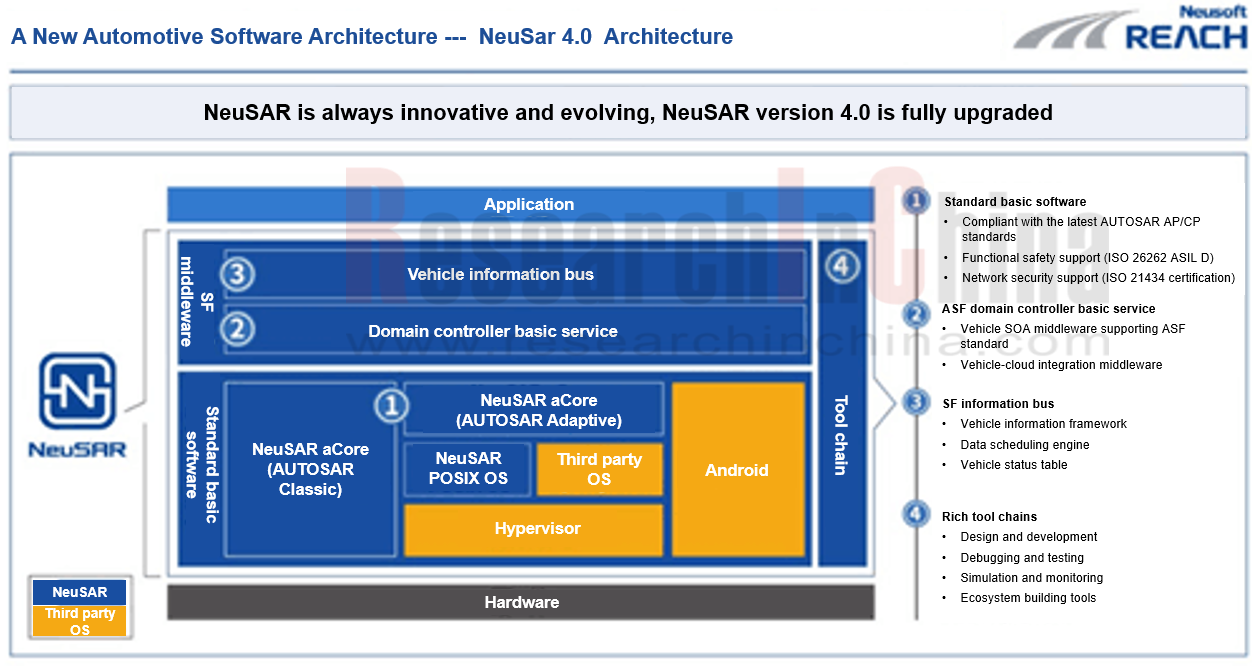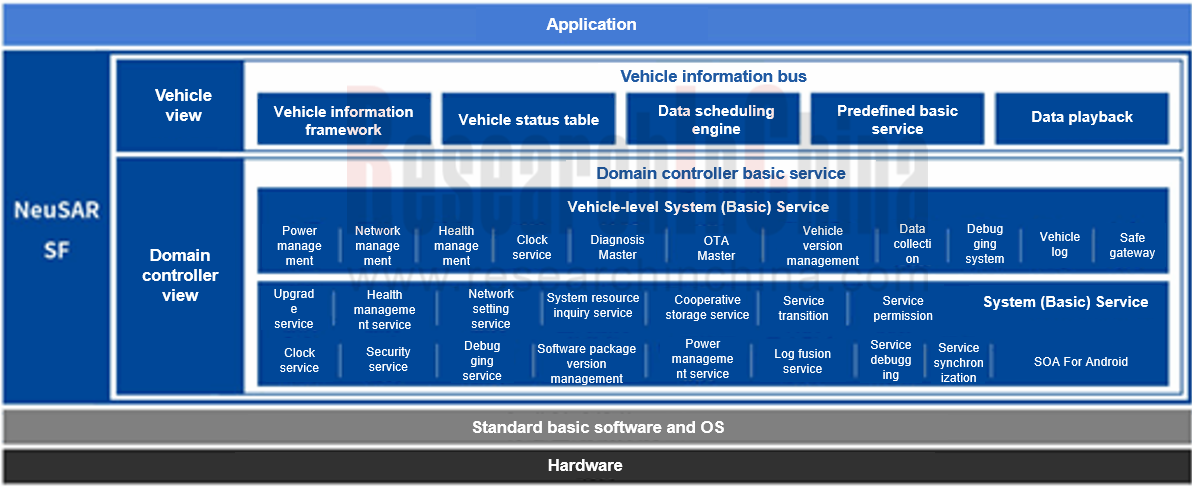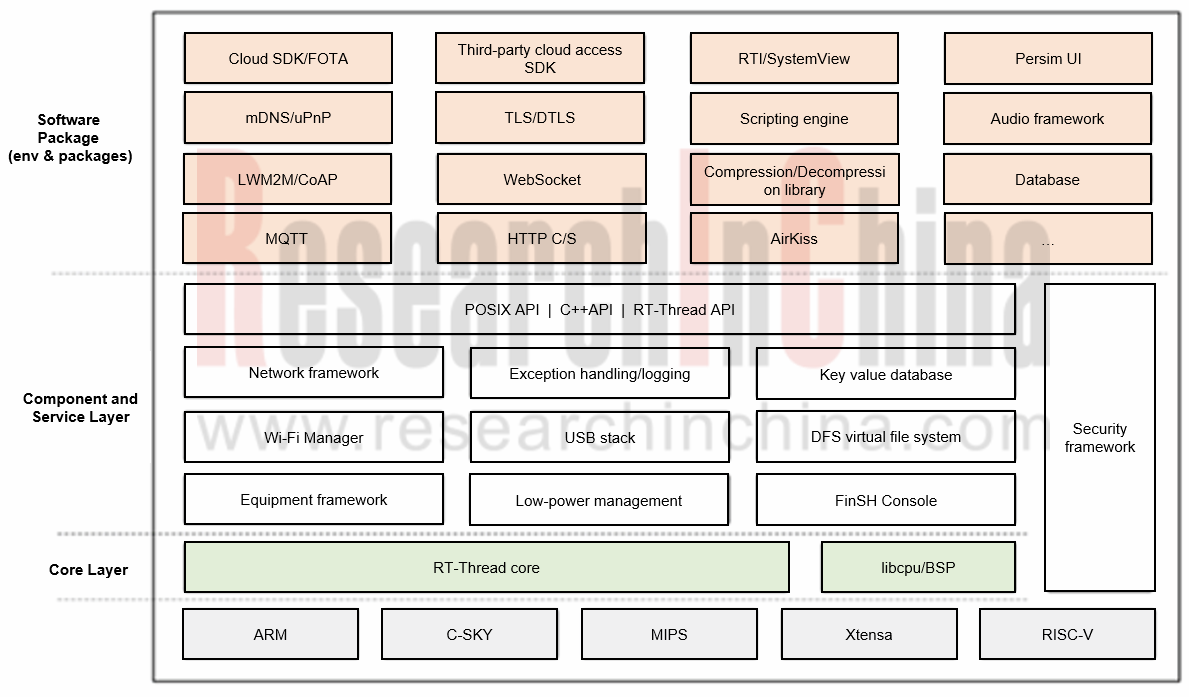Global and China Automotive Operating System (OS) Industry Report,2022
Operating system research: the automotive operating system for software and hardware cooperation enters the fast lane.
Basic operating system: foreign providers refine and burnish functions; Chinese providers expand software and hardware cooperation.
Internationally, Blackberry's QNX, Linux-based custom operating system, and Android open source project-based operating system are still the three major basic operating systems. In 2022, centering on the benefits of their own products, the three major providers, Blackberry, Intel & Linux Foundation, and Google, play to their strengths, and vigorously expand ecosystem cooperation with OEMs in more aspects: QNX works hard on software and hardware hybrid high-performance computing platforms to facilitate development of "software-defined vehicles"; Intel & Linux Foundation, and Google expanded the cooperation with Chinese and European OEMs, respectively.
In China, Alibaba's AliOS and Huawei's HarmonyOS focusing on autonomous driving and intelligent cockpit, separately, upgrade underlying operating systems ecologically, and join hands with hardware suppliers to create cooperative software-hardware platforms and launch smart mobilOity system solutions.

General operating system: Chinese providers develop diversified functions and create "system + hardware" ecosystems.
In China, the general operating system is oriented to infotainment and intelligent cockpit, and highlights the abundance of ecological resources, and the diversity of services and applications, meeting the individual needs of users, and building ecosystems. Most Chinese general operating systems are developed on Android. The 10 key Chinese providers in this report start with intelligent scene perception and intelligent cockpit, and team up with hardware suppliers to introduce system solutions of "domestic operating system + domestic chip". They also promote custom development of tools such as SDK and software computing platforms, allowing for secondary development in the fields of intelligent cockpit and autonomous driving, and creating diversified, customized and ecological comprehensive operating system solutions.

Neusoft NeuSAR
To solve the problem that the conventional development models can no longer meet the market’s requirements for vehicle development speed and functional iteration, Neusoft Reach introduced NeuSAR4.0 in December 2022, aiming to build an industry ecosystem.

The NeuSAR4.0 upgrades the NeuSAR SF service framework, with advantages in four aspects: the further decoupling of application development software and hardware enables dynamic migration of functions; the more efficient simulation and debugging functions achieves global synchronization of data; the flexible deployment of message channels meets the needs of different application scenarios; the "vehicle" and "cloud" connection allows for the integration of vehicle and cloud services.

In addition, NeuSAR4.0 has upgraded the NeuSAR DevKit tool chain, covering NeuSAR Creator (IDE-like integrated development tool), NeuSAR Monitor and NeuSAR Simulator, which can realize the entire domain controller development process, and monitor some dynamic resources in the development process, and simulate the third-party devices that need to be used in the development process, respectively.
ArcherMind Fusion OS
Based on the cooperation with chip vendors like Qualcomm, Renesas, Nvidia, and NXP, ArcherMind launched a fully self-developed cross-domain integrated vehicle software computing platform FusionOS in 2022. As a general operating system middleware solution, it includes intelligent cockpit domain EX6.0, central control domain Fusion3.0, intelligent driving domain operating system solution FusionAD, and cross-domain fusion software operating system solution.
Fusion SOA software platform that covers the six solutions of middleware layer, service layer, operating system & hardware layer, cloud, tool chain, and service plug-in, provides full-stack SOA technical capabilities with mass production experience. It has been adapted to the latest cockpit platforms of multiple automotive-grade chip vendors like Qualcomm, Renesas and SemiDrive, and supports QNX, Android, Linux and other operating systems. It also provides a fully optimized graphics system, AI Orchestra Engine middleware and the latest voice algorithm engine AM Acoustic Engine.
RT-Thread "Cheng Xuan" Vehicle Fusion Software Platform
In 2022, RT-Thread announced the RT-Thread "Cheng Xuan" Vehicle Fusion Software Platform, an embedded real-time operating system composed of kernel, network, file system, and GUI components.
Based on virtualization system vmRT-Thread Hypervisor, Cheng Xuan Vehicle Fusion Software Platform carries the safe real-time system RT-Thread Secure Auto, the microkernel operating system RT-Thread Smart Auto, and Linux or other systems, and can be compatible with multiple system platforms, making it easy to use. It enables information interaction via unified distributed message bus and upper module.

Hypervisor: foreign leading established providers boast much greater first-mover advantages, and Chinese players go all out to catch up.
In the global hypervisor market, automotive standard-compliant, mass-produced hypervisor products include Blackberry QNX Hypervisor, Wind River Vxworks, OpenSynergy COQOS, and Linux Foundation’s ACRN. In the field of automotive virtual layer in China, there are a growing number of companies independently developing hypervisor, for example, the likes of Banma Zhixing, iSOFT Infrastructure Software, Zlingsmart and ZTE all have technical strength of virtualization, but still lag far behind their foreign peers. The basic hypervisor type is Type-1, and Zlingsmart has realized mass production of its RAITE Hypervisor.
In 2022, foreign hypervisor providers concentrated on fostering partnerships with OEMs in smart mobility scenarios. For example, while maintaining its share in the market, QNX Hypervisor worked to expand application cooperation with such companies as Neta Auto and MarelliTech in driving and cockpit scenarios; OpenSynergy built hypervisor technology cooperation with Qualcomm Snapdragon Automotive Development Platform (ADP) and STMicroelectronics.

IVI mirroring system: build ecosystem barriers, and develop service ecosystems and interactive functions.
Apple Carplay, Google Android Auto, Baidu Carlife, and HUAWEI HiCar among others have established influence in IVI mirroring system market. These providers designate IVI mirroring systems for connecting their own brands, so as to pose a brand barrier. New entrants such as Xiaomi and Vivo are also vigorous in the market. Starting with IVI mirroring systems, they build an IoV ecosystem service system, and mainly offer the interactive perception and service connection functions of mirroring systems, which have yet to be used on large scale.

Autonomous Driving Domain Controller and Central Computing Unit (CCU) Industry Report, 2025
Research on Autonomous Driving Domain Controllers: Monthly Penetration Rate Exceeded 30% for the First Time, and 700T+ Ultrahigh-compute Domain Controller Products Are Rapidly Installed in Vehicles
L...
China Automotive Lighting and Ambient Lighting System Research Report, 2025
Automotive Lighting System Research: In 2025H1, Autonomous Driving System (ADS) Marker Lamps Saw an 11-Fold Year-on-Year Growth and the Installation Rate of Automotive LED Lighting Approached 90...
Ecological Domain and Automotive Hardware Expansion Research Report, 2025
ResearchInChina has released the Ecological Domain and Automotive Hardware Expansion Research Report, 2025, which delves into the application of various automotive extended hardware, supplier ecologic...
Automotive Seating Innovation Technology Trend Research Report, 2025
Automotive Seating Research: With Popularization of Comfort Functions, How to Properly "Stack Functions" for Seating?
This report studies the status quo of seating technologies and functions in aspe...
Research Report on Chinese Suppliers’ Overseas Layout of Intelligent Driving, 2025
Research on Overseas Layout of Intelligent Driving: There Are Multiple Challenges in Overseas Layout, and Light-Asset Cooperation with Foreign Suppliers Emerges as the Optimal Solution at Present
20...
High-Voltage Power Supply in New Energy Vehicle (BMS, BDU, Relay, Integrated Battery Box) Research Report, 2025
The high-voltage power supply system is a core component of new energy vehicles. The battery pack serves as the central energy source, with the capacity of power battery affecting the vehicle's range,...
Automotive Radio Frequency System-on-Chip (RF SoC) and Module Research Report, 2025
Automotive RF SoC Research: The Pace of Introducing "Nerve Endings" such as UWB, NTN Satellite Communication, NearLink, and WIFI into Intelligent Vehicles Quickens
RF SoC (Radio Frequency Syst...
Automotive Power Management ICs and Signal Chain Chips Industry Research Report, 2025
Analog chips are used to process continuous analog signals from the natural world, such as light, sound, electricity/magnetism, position/speed/acceleration, and temperature. They are mainly composed o...
Global and China Electronic Rearview Mirror Industry Report, 2025
Based on the installation location, electronic rearview mirrors can be divided into electronic interior rearview mirrors (i.e., streaming media rearview mirrors) and electronic exterior rearview mirro...
Intelligent Cockpit Tier 1 Supplier Research Report, 2025 (Chinese Companies)
Intelligent Cockpit Tier1 Suppliers Research: Emerging AI Cockpit Products Fuel Layout of Full-Scenario Cockpit Ecosystem
This report mainly analyzes the current layout, innovative products, and deve...
Next-generation Central and Zonal Communication Network Topology and Chip Industry Research Report, 2025
The automotive E/E architecture is evolving towards a "central computing + zonal control" architecture, where the central computing platform is responsible for high-computing-power tasks, and zonal co...
Vehicle-road-cloud Integration and C-V2X Industry Research Report, 2025
Vehicle-side C-V2X Application Scenarios: Transition from R16 to R17, Providing a Communication Base for High-level Autonomous Driving, with the C-V2X On-board Explosion Period Approaching
In 2024, t...
Intelligent Cockpit Patent Analysis Report, 2025
Patent Trend: Three Major Directions of Intelligent Cockpits in 2025
This report explores the development trends of cutting-edge intelligent cockpits from the perspective of patents. The research sco...
Smart Car Information Security (Cybersecurity and Data Security) Research Report, 2025
Research on Automotive Information Security: AI Fusion Intelligent Protection and Ecological Collaboration Ensure Cybersecurity and Data Security
At present, what are the security risks faced by inte...
New Energy Vehicle 800-1000V High-Voltage Architecture and Supply Chain Research Report, 2025
Research on 800-1000V Architecture: to be installed in over 7 million vehicles in 2030, marking the arrival of the era of full-domain high voltage and megawatt supercharging.
In 2025, the 800-1000V h...
Foreign Tier 1 ADAS Suppliers Industry Research Report 2025
Research on Overseas Tier 1 ADAS Suppliers: Three Paths for Foreign Enterprises to Transfer to NOA
Foreign Tier 1 ADAS suppliers are obviously lagging behind in the field of NOA.
In 2024, Aptiv (2.6...
VLA Large Model Applications in Automotive and Robotics Research Report, 2025
ResearchInChina releases "VLA Large Model Applications in Automotive and Robotics Research Report, 2025": The report summarizes and analyzes the technical origin, development stages, application cases...
OEMs’ Next-generation In-vehicle Infotainment (IVI) System Trends Report, 2025
ResearchInChina releases the "OEMs’ Next-generation In-vehicle Infotainment (IVI) System Trends Report, 2025", which sorts out iterative development context of mainstream automakers in terms of infota...